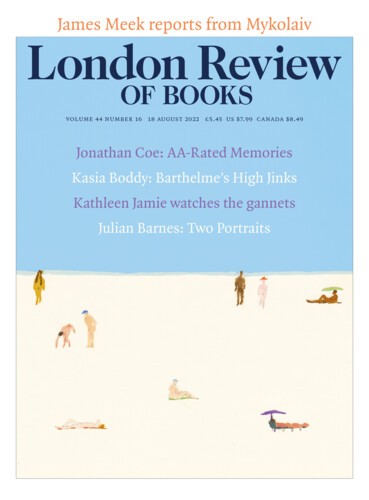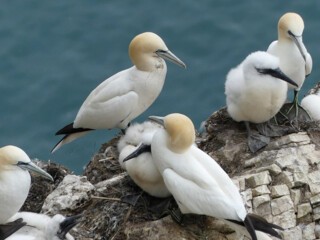Iclimbed a low cliff and stationed myself on a bench that overlooked the Firth of Forth. From Kinghorn, the Fife coast and the coast of East Lothian appear to peel away from each other; on the horizon lies the North Sea. There are several islands out in the firth and, as usual, a number of ships were riding at anchor. The ships were connected to the oil industry: the Grangemouth refinery is a few miles upriver. How innocent they seemed, turning on the tide.
Last time I was here it was winter and I was watching humpback whales. This time I hardly dared lift the binoculars. That’s never happened to me before: a reluctance to go to the coast and, once there, a reluctance to scan the waves. But twenty miles due east down the firth stands the Bass Rock, the biggest gannetry on earth. The Bass is the plug of an ancient volcano. Nowadays, 150,000 gannets nest on its rocky flanks, and all over its plateau. So many gannets that the island gleams white with wings and guano. But today, even from this distance the colony looked depleted. More naked rock visible, fewer birds.
The Scottish gannet colonies are wonder-walls through spring and summer. I can rhyme them off: Noss and Hermaness, Sula Sgeir, Stac Li and Stac an Armin, Ailsa Craig. These ones are ancient. There are also newish ones on the Aberdeenshire mainland at Troup Head, and on Westray in Orkney. There’s only one colony in England, at Bempton Cliffs in Yorkshire. Silent and elegant at sea, gannets make a racket in their colonies, with breeding pairs crammed bickering on nests wreathed with seaweed and plastic crap. It’s a constant airlift as birds supply food and ever more nest material. If you walk on the cliff above, you get the updraft hit of ammonia, feathers and guttural argy-bargy. From below, on a boat, you can gaze up through layers of birds as they hang in cruciform shapes above you like a fabulous mobile, giving you the cold blue eye. Actually, it looks hellish. Imagine being confined for months in an overcrowded parents and toddlers club, except when you slip out for a swift gin.
As well as gannetries, all around the summer coast are tenements of auks, gyres of puffins, tern colonies and the ever patrolling bonxies, the great skuas – a piratical bird. ‘Bonxie’ is a Shetland name, now universally adopted. It suggests something of their tundra-brown weightiness, their gimlet eye. To eat, they harass other birds while they’re flying, especially gannets, until the victim is so stressed it sicks up its dinner, which the bonxie swipes. They nest on open ground; stray too close, and the bonxie will drive you away by flying straight at your head. (Once, on North Rona, my friend Stuart and I were walking along when a bonxie took exception to us. It came in fast, misjudged its height and walloped Stuart so hard it burst his eardrum.)
I could see the Bass on the horizon on the south edge of the firth. Further north lies the lower Isle of May, a mile long. I try to go to the May in May every year, to mark my birthday; a tourist boat sails daily from Anstruther throughout the season. Or ordinarily it does. In 2018, I went not in May but in late April, the week after my father died. Visitors go for the abundance of birds, and the photo opportunities: the cliff ledges stacked with rows and rows of auks, and the flighty terns, and the slovenly teenage-bedroom shags’ nests. There are birds on the cliffs, and puffins stand at their burrow doors on the turf above. I went out to the May this year to show the seabirds to a young friend, a student of Arctic biology. Anna was studying in Tromsø and had been on a research ship right up to the ice. She had witnessed polar bears hunting ringed seals, but she had never seen anything like the May. That was then.
Highly pathogenic avian influenza H5N1 is a known disease in poultry, but now it is scything through wild birds. Last winter it was on the Solway, killing migrant geese. This year it hit the Bass at peak breeding time. Drone footage by Edinburgh University and the Scottish Seabird Centre shows gannets lying dead in their nests, next to their chicks and partners. They’re hanging dead from the cliffs. They’re floating dead on the water, a wreck of feathers. They’re dead on the beaches, all down the coast. A friend on Shetland writes that they’re dying there too. She sent a photograph of a dead gannet tangled in seaweed, its long neck twisted. ‘The body of this gannet came ashore while I was on the beach, there were maybe five other dead gannets in this stretch of the coastline.’
It’s not only the gannets. It’s affecting gulls and guillemots. They’re dying at St Abbs, just north of the border with England. Gannets have some safety in numbers, and may weather the crisis, but in a recent podcast by the Scottish Ornithologists’ Club, David Steel, the reserve manager for the Isle of May, says he fears that a third of the world’s bonxies may already be dead. It’s possible that without constant pressure from skuas, other species like kittiwakes and petrels may have a better breeding year. There’s just the lack of food to contend with, the plastic, the warming seas.
What’s lovely about the Bass from a distance is the shaken snow-dome effect of so many gannets in flight, the coming and going and hanging in the air, the dandruff-drift. Were there enough birds alive to create this summer spectacle now? When I dared to lift the binoculars I could see nothing at all – I hadn’t reckoned with the heat haze. It was still warm, though temperatures were back down after the recent forty-degree heat, when people watched their houses burn. When nature reserves went up in smoke.
It’s been a while since we have been able to turn to the natural world for reassurance, to map the arc of an individual life against the eternal cycle of the seasons, the birds, the hills. That’s probably why I went out to the Isle of May when my dad died, looking for the old comforts. It was spring, life’s resurgence, the seabirds’ welcome return. But the feeling of being imperilled is now constant: the sense that something is cracking like a parched field, the veneer of our hitherto secure lives. Temperatures climb, the world burns, ice melts, pandemics erupt, and now the seabirds are dying. There they are, the conservation workers, among their beloved birds at the height of the breeding season, wearing hazmat suits as they pile corpses into bin bags.
Where is this disease coming from? I asked Will Miles, a seabird ecologist living in Shetland, if this variant had spread from intensive poultry farms, the kinds of place that supply high street cheap chicken shacks. Is it another anthropogenic disaster? He counselled against such speculation, suggesting that the desire to find an ‘origin’ may be mistaken. The virus is now free-living, transmitted through natural processes, through the birds’ life cycle. It’s ‘unprecedented, highly complex and extremely unpredictable’, he said. It’s horribly transmissible, by air and water, but the scariest thing is its persistence. It killed hundreds of bonxies on Shetland last year and Miles was glad to see the survivors leave at the season’s end. But the disease broke out again as soon as the birds returned this spring: it had probably persisted all winter in the water of the freshwater lochans where the birds gather in social clubs. If the virus overwinters in other species’ colonies, this year’s disaster could be just the beginning. But there are so many unknowns: it affects different species differently, and the same species differently in different places. It can be deadly and widespread in one guillemot colony, and less so in another. Unprecedented. How many times have we heard that word, these last few years? Unprecedented events, whether human-induced or not.
A few days ago NatureScot – what used to be known as Scottish Natural Heritage – issued a list of 23 small, uninhabited islands it is asking people not to visit, in an attempt to reduce the spread of avian influenza. It’s a small gesture – the birds have myriad ways to spread the virus among themselves. Noss and the Isle of May were already closed to landing parties. In itself, the list is a lovely litany: Swona and Muckle Skerry, Soay, Boreray, Ramna Stacks, Treshnish, Fidra and Lamb. ‘Devastating’, ‘tragic’, the press release says. Is that what the islands have come to mean, for the foreseeable future? The smell of death. The virus is on the Farne Islands, where it has killed at least three thousand birds. It’s on Coquet Island, off the Northumberland coast, laying waste to roseate terns. They are Europe’s rarest nesting seabird; the only UK colony is on Coquet. Thanks to conservationists, they are recovering from near extinction, or they were. Terns live in perpetual daylight; some species migrate from high in the northern hemisphere down to the Antarctic. If they take the virus with them, it could get into the albatross population, then spread to the penguins.
I have been talking about wild seabirds, but the flu has also turned up in lapwings, coots, peregrines. It’s reached Svalbard, which holds huge seabird colonies. Anna, now working at a veterinary lab in Tromsø, says the anxiety in the far north is for arctic foxes, as well as the birds themselves.
From my Kinghorn bench, I faced the sea. What does the sea even mean? I suppose when I was young, and made journeys to Orkney and Shetland, and witnessed for the first time the swirl of innumerable seabirds and the Atlantic beyond, the sea stood for both vastness and security. ‘You can’t harm this,’ I wrote in an early poem, about the ocean. Oh how wrong.
The light glanced on the water. Hallelujah: a pennant of twenty-odd gannets passed, flying strongly, now rising, now falling. They would be Bass Rock birds. Plumes of water rose when a few folded their lovely black-tipped wings and plunge-dived. What use the summer sunlight, if it can’t gleam on a gannet’s back? It’s possible we won’t know the real extent of this catastrophe until next year at the earliest, or maybe several years from now, if and when it finally runs its course and surveyors can get into the colonies and conduct proper counts. Stay alive! I said to the gannets. I say it to geese, terns, every herring gull I see, raiding every bin. Stay alive! Stay alive! Stay alive!
Send Letters To:
The Editor
London Review of Books,
28 Little Russell Street
London, WC1A 2HN
letters@lrb.co.uk
Please include name, address, and a telephone number.


